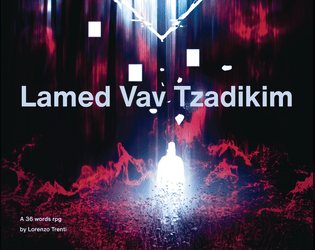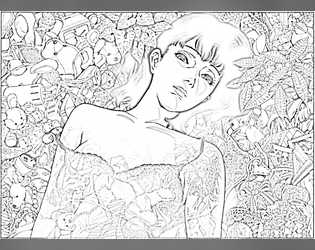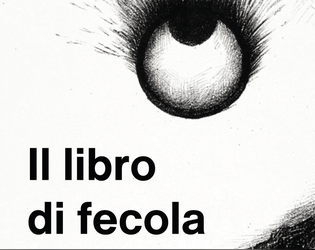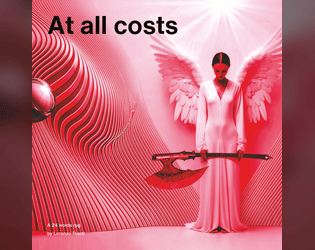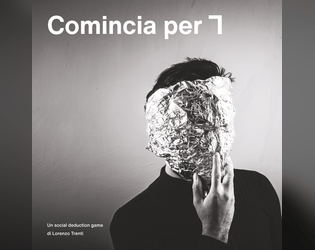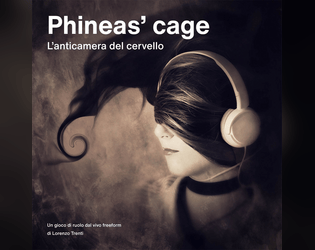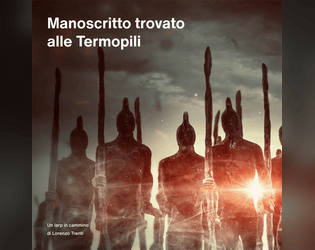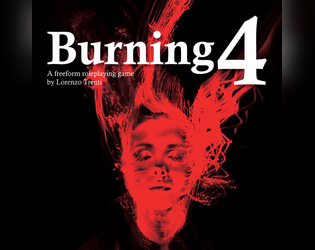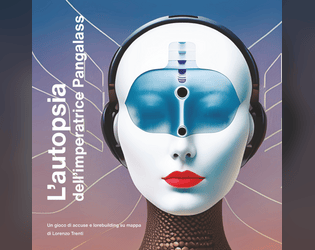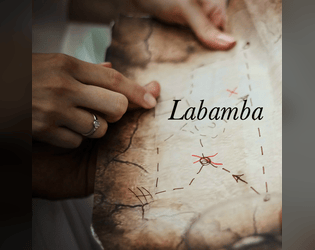Love how you took elements from Twin Peaks and transformed them into puzzle pieces that can be reassmbled.
MrValis
Creator of
Recent community posts
We played the game in ArConate, Italy. The premise is very funny and we enjoyed the sessione, but I think the rules lack a bit of advice, like:
- successful Scare moves reduce the victim's Courage of... what amount?
- can a ghost with less than 4 Presence move freely in the house when no Occupant looks at it? (it should be a Difficulty 4 move, but it's impossibile if you have fewer than 4 dice - unless, of course, you spend Malice)
- making the House reactions was quite difficult: I think I need more examples.
Thanks in advance.
Hi! Great premise, I'm willing to play the game as soon as possible. I wonder what's the supposed game time (is it possibile to play the game in a one-shot session of 3-4 hours?).
Also, may I ask you if I have understood correctly how Dreams work? Let's say I'ma the Mistress and I have girls A, B and C.
Case 1: A sleeps, B and C stay awake
- A answers first Dream prompt
- B takes an action (meaning it's not a single Move/roll but a scene with thematic unity, I guess)
- C takes an action
... repeat until A has answered all the Dream prompts. B and C, if still in action, abruptly end their investigations (I suppose it's a sort of cinematical cut to to the Dawn phase? I guess we define together what happened in fiction between the cut and the Dawn?).
Case 2: A, B and C stay awake
- A answers the first Dream prompt
- A takes an action
- B takes an action
- C takes an action
- B answers the second Dream prompt
- A takes an action
- B takes an action
- C takes an action
- C answers the third Dream prompt
- A takes an action
- B takes an action
- C takes an action
... and so on until the Dream prompts are finished.
Is it how you intended the game to be played?
Thanks in advance!
PS: on page 21 on Twilight, it says "and the Day begins" but really should be the Night.
PPS: on page 15 I suppose you roll the dice (like in Brindlewood Bay) but it's not specified clearly.
We tried to play it but the game didn't work 100% for us. Since we liked a lot of the premise, and the parts where the non-focus players collaboratively contribute to the description of the zone (really creepy and surreal scenes here!), I hope I can offer constructive advice.
Firs of all, I think we needed some examples of play. There are some phases where we didn't exactly know what to do - like when you re-enter a Zone and the Memory "plays again". What does that mean? Also the four activities that you can choose to move forward weren't self explanatory and could benefit from a list of examples.
We also had some questions, like: who gets to write down the Memory? Wouldn't it be better to specify it? (the focus players, the player sitting on the right of the focus player, or something like that). Also, when re-entering a Zone, the game says to write new sensory details. Does it mean that the sensory details *add* to the former ones or do they *replace* them? We went for the first interpretation but I still have doubts.
The thing that broke our game apart was its duration. After two complete rounds (each of the 4 players being the focus for two times) and 2.5 hours of playing, we had failed the roll just two times. This way we had just two ticks on the Collapse clock and the end of the game seemed very far for our time slot, contrary to the "1-3 hours" label on the cover. We had the doubt that the game intended us to mark one tick on the Collapse clock *for every scene*, and just further increase this rythm when the focus player fails the throw, but we didn't find this info anywhere.
Also, in the end we felt we lacked some focus. Some of the characters had a social objective that you can get only when meeting each others - but after eight scenes we where still apart and no one had met any one other. Generally speaking, all the players seemed to perceive that the only active choice was "holding on until the Cube collapses". The fact that the PTSDemons weren't based on the traumas of a single character but were generic incarnations/metaphors of toxic behaviours made us play the game as a long nightmare - which in the end was entertaining but, as said before, lacked some focus.
Finally a question about the play aids. What's the Map of the Hypercube? Is it the upper part of the character sheet? If so, what do the little hexagon with "1 tick", 2 tick", ecc. represent...? We didn't understand.
Since we liked the premise of the game, we have some suggestions. :)
- list the Negative beliefs on the character sheet so that every player can easily read them;
- separate the map of the cube from the character sheet, and specify somewhere the 4 types of activities to move forward (not just the name and the type of roll, but at least the same subtitle from the game manual); also, add the Collapse clock to the Cube map;
- give players the chance to actively explore the cube, be it selecting the next zone (maybe everyone bids secretly) or rolling to obtain tokens/points of some kind that you can accumulate to try and escape the cube before the collapse (but of course some character could stay inside to help others escape);
- if the zones merge, make the PTSDemons appear together instead of merge them (to make them interact against the characters instead of just flatten them).
Thanks for reading all of this!
We played it and had a lot of fun. I chose to play as a traditional GM to speed things up for the three players; we opted to play just five levels and in the end it seemed to be the right choice (ten levels would have been too long and maybe a bit repetitive).
I used just one monster for each level and in the end the characters (a Beautiful Explorer, a Quantistic Preacher and a Small-town Nomad) collaborated in overcoming every barrier (instead of making them roll singularly).
I have a question about tools breaking with 1's. If I have an Advantage, roll 2d6, get 1 and 6, the roll is a success but the tool breaks?
My aim was having an emergent gameplay where you have several moves and the obsession of the characters can bleed to the obsession of players. I envision a game where one player goes on and on on the way to ascending farther than human, while all the other players used "Do without me / Fate senza di me" and continue to knock down the life of that PC with mundane events. All in all it must obviusly be played to see what actually comes out if it. Thanks for your review!
Never thought of Borges' tales as "noir" and your introduction had my whole attention. I really liked the structure of roles (Personas) and characters.
I think that character creation could be more refined (maybe asking each other questions instead of filling blank spaces); I'd like to had some examples of motives.
I really liked the creative use of Memories and the the second iteration of the game (I think that changing Personas is the most interesting versione, while changing just the characters results in just another iteration of the game).
The game is a fascinating reading and perfectly captures the feeling of Borges' style of writing; many times I've smiled while reading the text. Also, I really appreciated that the author tried to tie those references to rules and not just suggestions (like "passing the turn with a dismissive gesture").
I'm not sure I understood correctly the rule about bifurcation, namely "The chapter may preserve the unity of space or time, but not both".
I think that - similarly to my own game - "La ciudad" can actually be played consistently in a single session (I must admit I didn't take the restriction of "play this game in multiple session" as a fundamental one; on the other side it was not strictly part of the theme, rules or ingredients...).
Very curios about playing it.
Direi che al terzo commentatore che dice che non ha letto il racconto, la nuova versione del regolamento dovrà includere che non è ispirato a un racconto nello specifico. :-) Il fatto comunque che tutti abbiamo creduto trattarsi di un racconto effettivo di Buzzati depone a favore dell'aderenza del gioco alla jam.
Grazie dei commenti. Avevo pensato a lasciare indicazioni per giocarlo in videocall, poi per ragioni di tempo non le avevo incorporate. Fondamentalmente si tratterebbe di aprire tante chat quanti sono i partecipanti, in ogni chat ci sono tutti meno un giocatore, e in quella chat si condivide il problema del giocatore mancante. Non mi vengono in mente altri strumenti per realizzarlo.
Un'opera sontuosa, il cui approccio di design sui limiti della conoscenza positivistica mi ha ricordato quella storia dei sette saggi ciechi, ognuno dei quali esperisce al tatto una parte diversa dell'elefante e nessuno riesce a comunicare con l'altro.
Molto divertente il vincolo del numero di parole generato dal dado.
L'impianto regolistico sembra solido, unico piccolo dubbio che ho è se ci sia in qualche modo uno sviluppo dei personaggi o se sono solo "personaggi funzione", in qualità di esperitori dei diversi aspetti del Colombre.
Il racconto alla base del gioco è uno dei più belli di Buzzati (almeno, tra quelli che ho letto). Interessante l'idea degli haiku di gruppo (mi sembra obiettabile la frase "l’unica forma letteraria di quei luoghi ad aver stregato l’occidente è lo Haiku", ma sto spaccando il capello ^_^).
Dei due sottogiochi proposti, quello del principe mi sembra quello tematicamente più unitario e in grado di raccontare potenzialmente una storia, mentre quello dei messaggeri ha una meccanica più intrigante (la scrittura surrealista, una riga per uno, come nei "cadaveri squisiti") ma appare un po' meno focalizzato.
Se sviluppi il gioco con più calma sarebbe interessante miscelare questi due giochi (anche nel racconto originario in fondo c'è la dialettica continua tra ciò che il principe invia alla capitale e quello che egli riceve da casa).
Un altro possibile sviluppo potrebbe essere dato dall'integrare una serie di spunti casuali per rendere più vari luoghi ed eventi, es. un generatore di "notizie da casa". Questo soprattutto per giocarlo in modalità singolo giocatore.
Non ho letto il racconto a cui si ispira il gioco, ma comunque il feeling è molto forte ed evocativo.
Non sono un amante dei giochi in solitaria ma questo mi ha emozionato positivamente: mentre l'ho letto mi immaginavo la possibile generazione creativa di spunti.
Sarebbe ovviamente da verificare, con più sessioni, la tenuta meccanica delle varie currency e dei valori che transano in gioco.
Per il mio gioco ho unito due racconti, Una cosa che comincia per elle e Sette piani. Ecco il risultato: https://mrvalis.itch.io/comincia-per-7
Played it at ArConate in Italy in 5 players and it was appreciated very much.
One thing we noticed: more than 50% of the times, the Rusalka player gave the offering and then someone else had to remind him of the flashback, because someone else (usually the petitioner) wanted to comment and interact with what the Rusalka just said. We suggest to invert the prompts on the cards: first the flashback, then the gift. This way we have first an insight into the mortal life of the Rusalka, and then we switch back to the present, where the choice of a particular gift (or refusal) might be motivated by the backstory.
Also, I think that page 29 in the pdf ("Petitioner") is out of order.
Thanks and ciao.


